It has long been known by economists, but ignored by planners, that urban containment policies create speculators markets. This has been especially evident in Vancouver, the third most unaffordable market in the Demographia International Housing Affordability Survey, and Toronto, which has experienced record breaking house cost escalation relative to incomes since enacting its “Places to Grow” urban containment policy in the middle 2000s.
Evidence continues to mount to support the relationship between urban containment policy and speculative profits. Now the Globe and Mail, one of Canada’s national newspapers, reports that realtors in Vancouver “are working with developers to obtain preferential access to condos in the Vancouver area.” The Globe and Mail also found that “ Many realtors also purchased one or more presale units for themselves and then resold them for six-figure profits.” Further, “A look at six buildings found flips for insiders and foreign investors brought a windfall of $10.6-million.”
Reprehensible as this is, it is to be expected. Vancouver has not only increased poverty by its urban containment policies that profoundly increase house prices, but also provided heretofore unavailable “get-rich-quick” schemes to make life even worse for those whose choice is a lower standard of living in Vancouver, or an unwanted move elsewhere just to enjoy the average lifestyle of other Canadians.














